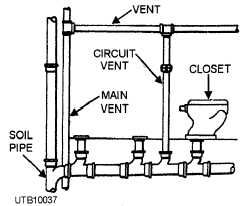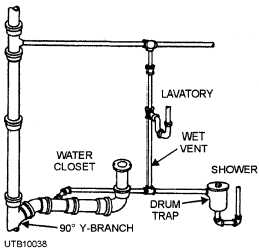either side of a partition (as shown in the illustration). A point to note is that the waste from both fixtures discharges into a double sanitary tee.
A CIRCUIT VENT serves a group of fixtures. As shown in figure 3-37, a circuit vent extends from the main vent to a position on the horizontal branch between the last two fixture connections. Make sure that a maximum of eight fixtures are put on any one circuit. If you have more than eight fixtures to be circuit vented, use two circuits instead of one. In this type of vent, water and waste discharged by the last fixture tends to scour the vents of other fixtures on the line.
A vent pipe, in which liquid wastes flow through a portion of it, is known as a WET VENT. A LOOP VENT is the same, except it connects into the stack unit to form a loop. This type of vent may be used on a small group of bathroom fixtures, such as a lavatory, water closet, and shower, as shown in figure 3-38. The pipe for a wet vent installation should be sized to take care of the lavatory, the water closet, and the shower.

Figure 3-37. - Water closets circuit vented.

Figure 3-38. - Wet vent.
NOTE When you are draining more than four fixture units, the wet vent should never be under 2 inches in diameter. A water closet must not drain into a wet vent.
As shown in figure 3-38, the lavatory should be individually vented. This is necessary to prevent loss of the trap seal through indirect siphonage. Another point to note with the lavatory is that the relatively clean water discharged from it tends to scour the wet vent, preventing an excessive buildup of waste material in the vent.
Installation Pointers
A venting system must be installed properly with little repair and upkeep. This section points out your duties in installing vent systems.
Refer to figure 3-39. Notice that a MAIN VENT TEE forms a junction between the main vent and the main soil and waste vent. This is a tapped tee having a stack side outlet. It should be installed by caulking in the vertical stack, at least 6 inches above the overflow level of the highest fixture connected. After this has been done, the vertical stack should be extended, full size or larger, through the roof to form the vent terminal. The pipe must extend at least 6 inches above the roof. If the roof is used for other than weather protection, the vent terminal must be 7 feet above the roof. The opening in the roof through which the main soil and waste vent runs must be properly waterproofed. Roof flashing is used for this purpose Roof flashing is made of galvanized iron or copper. Flashing is available in different sizes. Normally, the size of flashing needed for a job is determined by the size of the main soil and waste vent.
When installing roof flashing on a shingled roof, extend it under two courses of shingles above the pipe. On a flat roof, place it between layers of the roofing material and have the finishing layer over the top of the flashing. To complete the installation on either type of roof, always apply a coat of roofing cement as added protection against leakage.
In a cold climate, you must think about ways to prevent closure of the main soil and waste vent at the roof outlet by freezing. The air discharged by the main stack and waste vent is humid and condenses. This
Continue Reading